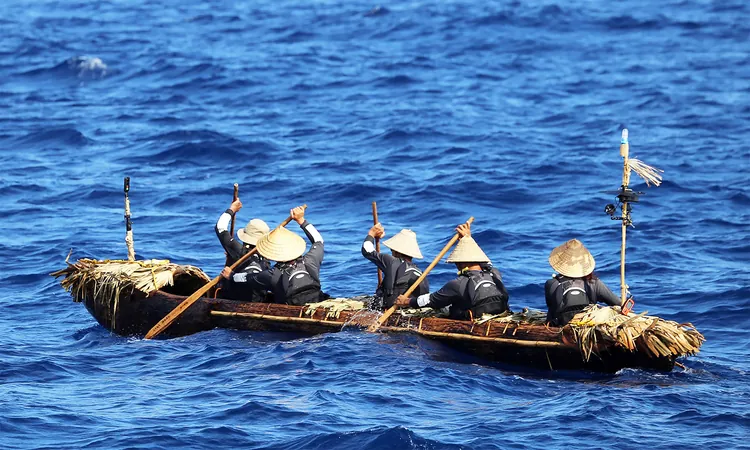
Unveiling a 30,000-Year-Old Ocean Journey: How Our Ancestors Crossed the Seas
2025-06-28
Author: Arjun
A Daring Voyage into the Unknown
Long before modern navigational tools or intricate maps, our early ancestors accomplished an astonishing feat: they traversed perilous open waters to settle on distant islands in East Asia. This epic journey, which took place around 30,000 years ago, saw brave souls leaving what is now Taiwan and heading for the southern islands of Japan, including Okinawa.
Decoding the Mystery of Ancient Navigation
The precise methods these pioneers used have baffled archaeologists for generations. In an effort to uncover the secrets of this ancient ocean crossing, a team led by Professor Yousuke Kaifu from the University of Tokyo embarked on a hands-on adventure that combined experimental archaeology with cutting-edge oceanic simulations.
Crafting History: Building Ancient Boats
Emulating these ancient voyagers, the researchers constructed traditional-style boats and even undertook modern expeditions to mimic the challenges of ancient navigation. Initial theories suggested that rafts might have been their vessels of choice, but following several attempts, it became clear that such flimsy crafts couldn’t withstand the fierce Kuroshio Current, one of the world's most powerful ocean currents. Instead, they found that sturdy dugout canoes were the key.
The Trial: A 140-Mile Paddle into History
In 2019, a 24-foot canoe dubbed Sugime was crafted from a single cedar log using replicas of stone tools from 30,000 years ago. Armed with just the stars, the sun, ocean swells, and their innate instincts, the team paddled a grueling 140 miles (225 kilometers) from eastern Taiwan to Yonaguni Island in Japan, a journey that stretched over 45 relentless hours with no land in sight.
Simulating Ancient Ocean Paths
This epic voyage represented only a fragment of the broader inquiry. Utilizing computer simulations, the researchers explored various routes, factoring in seasonal changes, starting points, oceanic currents, and paddling directions. Their digital explorations revealed that departing from northern Taiwan significantly increased the chances of success and that a subtle southeast trajectory could effectively counteract the strong northern pull of the Kuroshio.
Mastering Ocean Mastery
The findings suggest that these early mariners possessed not just survival skills but also a sophisticated understanding of ocean navigation. Despite the dangers, such journeys were most likely intended as one-way expeditions, as Professor Kaifu noted, returning was likely impractical, given the navigational knowledge of that time.
Celebrating Human Ingenuity and Resilience
This research not only sheds light on how humans may have crossed from Taiwan to Japan, but it also poses profound questions about human adaptability throughout history. Kaifu emphasized, 'Our Paleolithic ancestors faced formidable challenges, mirroring the strategic obstacles we encounter today.' Their journey demonstrates an impressive adaptation to their environment, echoing the navigational prowess of cultures like the Polynesians who roamed the vast Pacific.
Reviving the Spirit of Exploration
What started as an inquiry into a lost past culminated in an incredible journey that intertwined history, science, craftsmanship, and indomitable human spirit. By retracing these ancient paths, Kaifu's team has not only deepened our understanding of how humans spread across the globe but also reignited the timeless allure of exploration that defines humanity's journey through history.


 Brasil (PT)
Brasil (PT)
 Canada (EN)
Canada (EN)
 Chile (ES)
Chile (ES)
 Česko (CS)
Česko (CS)
 대한민국 (KO)
대한민국 (KO)
 España (ES)
España (ES)
 France (FR)
France (FR)
 Hong Kong (EN)
Hong Kong (EN)
 Italia (IT)
Italia (IT)
 日本 (JA)
日本 (JA)
 Magyarország (HU)
Magyarország (HU)
 Norge (NO)
Norge (NO)
 Polska (PL)
Polska (PL)
 Schweiz (DE)
Schweiz (DE)
 Singapore (EN)
Singapore (EN)
 Sverige (SV)
Sverige (SV)
 Suomi (FI)
Suomi (FI)
 Türkiye (TR)
Türkiye (TR)
 الإمارات العربية المتحدة (AR)
الإمارات العربية المتحدة (AR)